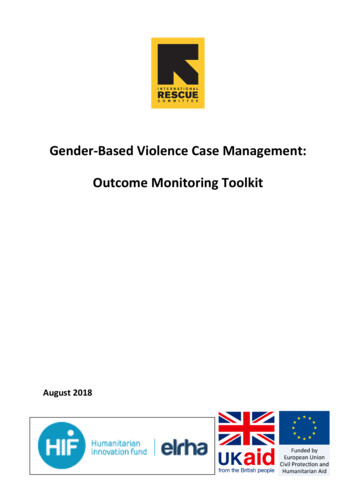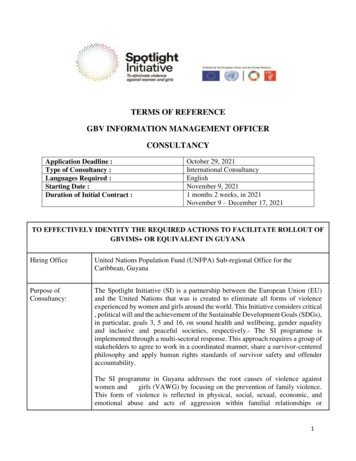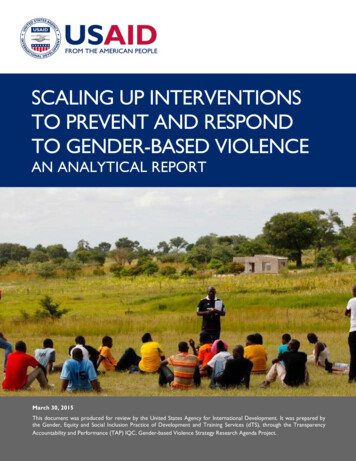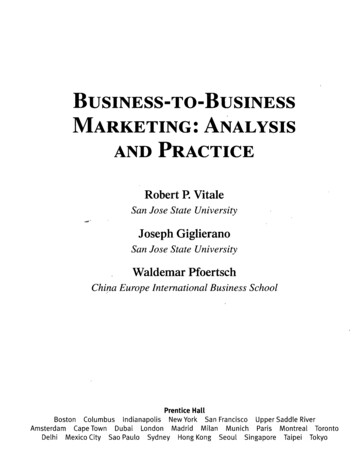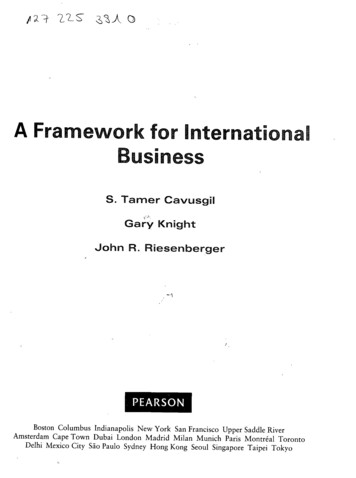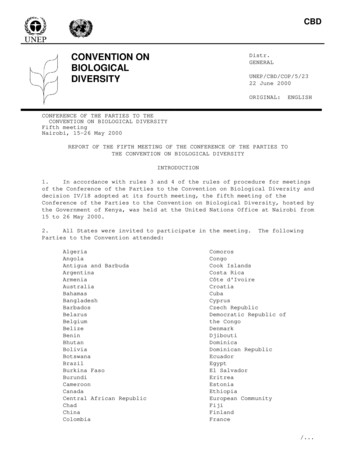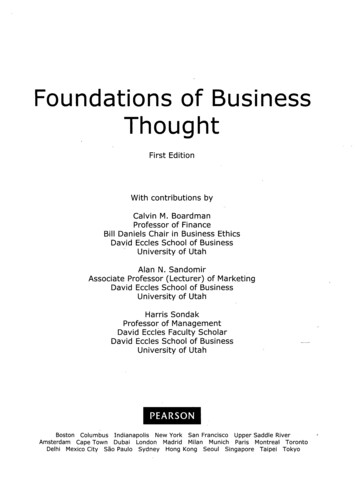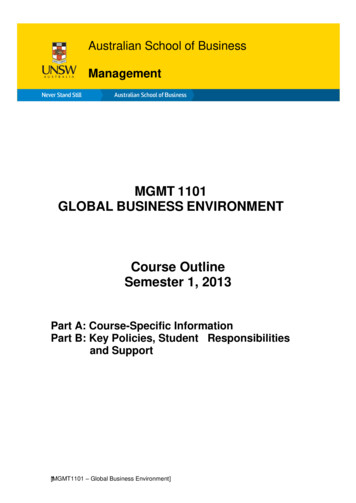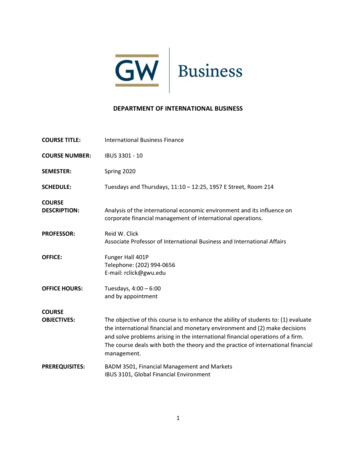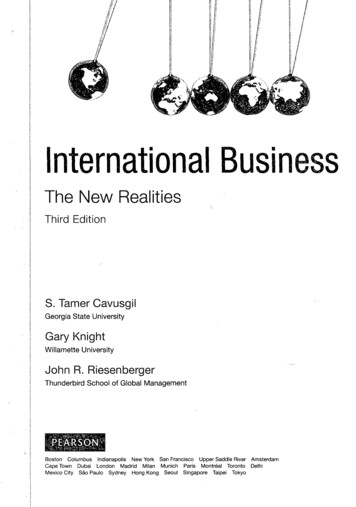
Transcription
International BusinessThe New RealitiesThird EditionS. Tamer CavusgilGeorgia State UniversityGary KnightWillamette UniversityJohn R. RiesenbergerThunderbird School of Global ManagementBoston Columbus Indianapolis New York San Francisco Upper Saddle River AmsterdamCape Town Dubai London Madrid Milan Munich Paris Montreal Toronto DelhiMexico City Sao Paulo Sydney Hong Kong Seoul Singapore Taipei Tokyo
ContentsPrefacexxviiPart 1 Foundation Concepts 2Introduction: What Is International Business? 3 Facebook: A Global Phenomenon 2What Are the Key Concepts in International Business? 5The Nature of International Trade 6The Nature of International Investment 7Services as Well as Products 8The International Financial Services Sector 9How Does International Business Differ from DomesticBusiness? 10The Four Risks in Internationalization 11Who Participates in International Business? 13Multinational Enterprise (MNE) 13Governments and Nongovernmental Organizations (NGOs) 15 Global Trend: DIESEL: A Smaller Firm's Smashing InternationalSuccess 15Why Do Firms Internationalize? 16Why Study International Business? 18Facilitator of the Global Economy and Interconnectedness 18Contributor to National Economic Well-Being 18A Competitive Advantage for the Firm 19A Competitive Advantage for You 19An Opportunity to Support Sustainability and Corporate Citizenship 19 You Can Do It Recent Grad in IB: Ashley Lumb 2 0 Closing Case: Internationalization at Harley-Davidson 21 Chapter Essentials: Key Terms 22 Summary 23 Test YourComprehension 23 Apply Your Understanding 24O globalEDGE Internet Exercises 24Globalization of Markets and the Internationalizationof the Firm 27. Bangalore: IT's Global Destination 26Why Globalization Is Not New 29Phases of Globalization 29Market Globalization: An Organizing Framework 31Dimensions of Market Globalization 32Drivers of Market Globalization 34Technological Advances 35xi0 0 0 0 0 0 0 0 0 . .0 0 0 0 0 0 0 0 o s o e o o o Q GS
xiiContentsInformation Technology 35Communications 38Manufacturing 39Transportation 39Societal Consequences of Market Globalization39 Global Trend: Globalization and E-Business in the Online WorldContagion: Rapid Spread of Monetary or Financial Crises 40Loss of National Sovereignty 41Offshoring and the Flight of Jobs 42Effect on the Poor 42Effect on Sustainability and the Natural Environment 43Effect on National Culture 46Globalization and Africa 4740Firm-Level Consequences of Market Globalization: Internationalizationof the Firm's Value Chain 47 Closing Case: Debating the Merits of Globalization49 Chapter Essentials: Key Terms 50 Summary 50Comprehension 51 Apply Your Understanding 52Test YourO globalEDGE Internet Exercises52Organizational Participants That Make InternationalBusiness Happen 55 The Emergence of Born Global Firms 54Four Types of Participants in International Business 56Participants Arranged by Value-Chain Activity 57Illustrating the International Value Chain Using Dell Inc.58Focal Firms in International Business 59The Multinational Enterprise (MNE) 60Small and Medium-Sized Enterprises 62Born Global Firms 62International Entry Strategies of Focal Firms 63A Framework for Classifying International Entry Strategies 63Other Types of International Entry Strategies 64Distribution Channel Intermediaries in International Business 66Intermediaries Based in the Foreign Market 67Intermediaries Based in the Home Country 68Online Intermediaries70Facilitators in International Business 70 Global Trend: Online Retailers Surge Ahead71Governments in International Business 73 Closing Case: DHL, FedEx, and UPS: Shifting Fortunes in the GlobalLogistics Services Industry 74 Chapter Essentials: Key Terms 75 Summary 76Comprehension 77 Apply Your Understanding 77O globalEDGE Internet Exercises78Test Your
ContentsPart 2 The Environment of International Business804 The Cultural Environment of InternationalBusiness 81S Culture and Management: Google in ChinaThe Nature of Cross-Cultural Risk 83Characteristics of Culture 85What Culture Is Not 85Socialization and Acculturation 86The Many Dimensions of Culture 86Lenses to Understand Culture 86High- and Low-Context Cultures 88Hofstede's Research on National Culture 89Cultural Metaphors 91Idioms 9180Subjective and Objective Dimensions of Culture 91Values and Attitudes 92Deal versus Relationship Orientation 92Example: Contrasting Mexico and the United States 92Manners and Customs 92Perceptions of Time 93Perceptions of Space 94Religion 94Symbolic Productions 95Material Productions and Creative Expressions of Culture 95Language: A Key Dimension of Culture 98Cultural Change 100Technology, the Internet, and Culture 100Globalization's Effect on Culture: Are Cultures Converging? 100Context of International Business 101Culture and the Services Sector 102Overcoming Cross-Cultural Risk: Managerial Guidelines102 You Can Do It Recent Grad in IB: Zhibo (Lawrence) Yu103: Global Trend: Minimizing Cross-Cultural Bias with Critical IncidentAnalysis 104 Closing Case: Hollywood's Influence on Global Culture105 Chapter Essentials: Key Terms 107 Summary 107Comprehension 108 Apply Your Understanding 108Test YourO globalEDGE Internet Exercises1095 Ethics, Sustainability, and Corporate Social Responsibilityin International Business 111 Corporate Social Responsibility at Coco-ColaEthical Challenges in International Business110113xiii
xivContentsIntellectual Property ViolationsBribery 115Corruption 116114Key Aspects of International Ethics 117The Value of Behaving Ethically 117Variation in Ethical Standards among Countries 118An Ethical Dilemma 118Linking Ethics, Corruption, and Responsible Behavior 119Corporate Social Responsibility 119The Value of CSR 120The Role of Sustainability in International Operations121 Global Trend: Global Corporate Social Responsibility Rises to the Topc of the MNE Agenda 122Corporate Governance and Its Implications for Managers 124Code of Conduct 124Deciding What Constitutes Ethical Behavior 125A Framework for Making Ethical DecisionsEmbracing CSR and Sustainability 127A Global Consensus 127 Closing Case: Corruption at Siemens125128 Chapter Essentials: Key Terms 130 Summary 130Comprehension 131 Apply Your Understanding 131O globalEDGE Internet ExercisesTest Your1326 Theories of International Trade and Investment;? 'Apple's Comparative and Competitive Advantages135134Why Do Nations Trade? 138Classical Theories 138How Can Nations Enhance Their Competitive Advantage?Contemporary Theories 145145 Global Trend: Moving from Comparative to National CompetitiveAdvantages 151Why and How Do Firms Internationalize? 151Company Internationalization 151How Can Internationalizing Firms Gain and Sustain CompetitiveAdvantage? 152—FDI-Based Explanations 152Non-FDI-Based Explanations 158 Closing Case: Hyundai: Leading the Way in the Global Auto Industry Chapter Essentials: Key Terms 160 Summary 161Comprehension 161 Apply Your Understanding 162O globalEDGE Internet Exercises159Test Your1637 Political and Legal Systems in National Environments 165; The Political and Legal Realities of Doing Business in RussiaThe Nature of Country Risk 166How Prevalent Is Country Risk? 166164
ContentsPolitical and Legal Environments in International Business168Political Systems 169Totalitarianism 169Socialism 170Democracy 170Democracy's Link to Economic Freedom and Openness 171The Relationship between Political Systems and Economic SystemsLegal Systems 173Common Law 173Civil Law 174Religious Law 174Mixed Systems 175Participants in Political and Legal SystemsGovernment 175International Organizations 175Regional Economic Blocs 176Special Interest Groups 176Competing Firms 176172175Types of Country Risk Produced by Political SystemsGovernment Takeover of Corporate Assets 177Embargoes and Sanctions 1.77Boycotts against Firms or Nations 178Terrorism 178War, Insurrection, and Violence 178Example: Country Risk in the Middle East 179177Types of Country Risk Produced by Legal Systems 179Country Risk Arising from the Host-Country Legal Environment 179Country Risk Arising from the Home-Country Legal Environment 181 Global Trend: Evolving Legal Aspects of E-CommerceManaging Country Risk 184Proactive Environmental Scanning 184Strict Adherence to Ethical Standards 184Alliances with Qualified Local Partners 184Protection through Legal Contracts 184183 Closing Case: Political, Legal, and Ethical Dilemmas in the GlobalPharmaceutical Industry 185 Chapter Essentials: Key Terms 187 Summary 187Comprehension 188 Apply Your Understanding 188Q globalEDGE Internet Exercises1898 Government Intervention in InternationalBusiness 191;' India's Transition to a Liberal Economy 190The Nature of Government Intervention 193Rationale for Government Intervention 194Defensive Rationale 195Offensive Rationale 196Test Yourxv
xviContentsInstruments of Government Intervention 196Tariffs 196Nontariff Trade Barriers 198Investment Barriers 200Subsidies and Other Government Support Programs 201Consequences of Government Intervention 203Evolution of Government Intervention 206General Agreement on Tariffs and Trade 207 Global Trend: The World Trade Organization and Collapseof the Doha Round 207Intervention and the Global Financial Crisis 208How Firms Can Respond to Government Intervention 208Strategies for Managers 208B Closing Case: Government Intervention at Airbus and BoeingH Chapter Essentials: Key Terms 212 Summary 212Comprehension 213 Apply Your Understanding 213O globalEDGE Internet Exercises210Test Your2149 Regional Economic Integration 217P Evolution of the European Union 216Regional Integration and Economic Blocs 219Levels of Regional Integration 219The Leading Economic Blocs 221The European Union (EU) 221European Free Trade Association (EFTA) 226North American Free Trade Agreement (NAFTA) 226 Global Trend: Troubles in the European Union 227El Mercado Comun del Sur (MERCOSUR) 228The Caribbean Community (CARICOM) 228Comunidad Andina de Naciones (CAN) 228Association of Southeast Asian Nations (ASEAN) 229Asia Pacific Economic Cooperation (APEC) 229Australia and New Zealand Closer Economic Relations Agreement (CER) 229Economic Integration in the Middle East and Africa 230Advantages of Regional Integration230Success Factors for Regional Integration 231Ethical Dilemmas and Drawbacks of Regional IntegrationSustainability of Firm and National Assets 233Management Implications of Regional Integration 235232 Closing Case: Russell Brands: Choosing between Global and RegionalFree Trade 236 Chapter Essentials: Key Terms 238 Summary 238Comprehension 239 Apply Your Understanding 239Q globalEDGE Internet ExercisesTest Your24010 Understanding Emerging Markets 243 The New Global Challengers: MNEs from Emerging Markets 242Advanced Economies, Developing Economies, and Emerging Markets 244
ContentsAdvanced Economies 245Developing Economies 245Emerging Market Economies 249What Makes Emerging Markets Attractive for International Business 251 Global Trend: China's Evolving Opportunities and ChallengesEmerging Markets as Target Markets 252Emerging Markets as Manufacturing Bases 253Emerging Markets as Sourcing Destinations 253Assessing the True Potential of Emerging Markets 253Per-Capita Income as an Indicator of Market Potential 254Middle Class as an Indicator of Market Potential 256Risks and Challenges of Emerging Markets 257Political Instability 257Weak Intellectual Property Protection 257Bureaucracy, Red Tape, and Lack of Transparency 257Poor Physical Infrastructure 258Partner Availability and Qualifications 258Dominance of Family Conglomerates 258Success Strategies for Emerging Markets 259Customize Offerings to Unique Emerging Market Needs 259Partner with Family Conglomerates 260252 You Can Do It Recent Grads in IB: Andrew S. Jamie WaskeyTarget Governments in Emerging Markets 261Skillfully Challenge Emerging Market Competitors 262Corporate Social Responsibility, Sustainability, and The Crisisof Global Poverty 263Foster Economic Development with Profitable Projects 263Microfinance to Facilitate Entrepreneurship 264The Special Case of Africa 264 Closing Case: Tata Group: India's New Global Challenger Chapter Essentials: Key Terms 268 Summary 268Comprehension 269 Apply Your Understanding 269O globalEDGE Internet Exercises261266Test Your27011 The International Monetary and Financial EnvironmentS The European Union and the Euro 272Exchange Rates and Currencies in International Business 274Convertible and Nonconvertible Currencies 275Foreign Exchange Markets 276Currency Risk 276How Exchange Rates Are DeterminedEconomic Growth 279Inflation and Interest Rates 279Market Psychology 280Government Action 280278Emergence of the Modern Exchange Rate SystemThe Bretton Woods Agreement 281The Modern Exchange Rate System 282281273xvii
xviiiContentsThe Monetary and Financial Systems 283International Monetary System 283Global Financial System 283 Global Trend: Global Financial Crisis284Key Players in the Monetary and Financial Systems 285The Firm 285National Stock Exchanges and Bond Markets 286Commercial Banks 286 You Can Do It Recent Grads in IB: Maria KeeleyCentral Banks 288The Bank for International Settlements 289International Monetary Fund 289The World Bank 290 The Global Debt Crisis 290 Closing Case: AIG and Global Financial Contagion287292 Chapter Essentials: Key Terms 294 Summary 294Comprehension 295 Apply Your Understanding 295O globalEDGE Internet ExercisesTest Your296Part 3 Strategy and Opportunity Assessment 29812 Strategy and Organization in the International Firm 299 IKEA's Global Strategy298Strategy in International Business 301Building the Global Firm 302Visionary Leadership 302Organizational Culture 304Organizational Processes 305The Distinction between Multidomestic and Global Industries 305The Integration-Responsiveness Framework 306Pressures for Global Integration 307Pressures for Local Responsiveness 307Strategies Based on the Integration-Responsiveness Framework 308Organizational Structure 311Centralized or Decentralized Structure? 311Organizational Structures for International Operations 312Export Department 313« International Division Structure 314Geographic Area Structure (Decentralized Structure) 315Product Structure (Centralized Structure) 315Functional Structure (Centralized Structure) 316Global Matrix Structure 316 Closing Case: Lenovo—The Global Challenger from an EmergingMarket 318 Chapter Essentials: Key Terms 320 Summary 320 Test YourComprehension 321 Apply Your Understanding 322O globalEDGE Internet Exercises 322
Contents13 Global Market Opportunity Assessment 325' Estimating Demand in Emerging Markets324Task One: Analyze Organizational Readiness to InternationalizeTask Two: Assess the Suitability of Products and Servicesfor Foreign Markets 330Task Three: Screen Countries to Identify Target Markets 331Screening Countries for Exporting 331 Global Trend: Global Macro Trends That Affect InternationalBusiness 333Country Screening for Foreign Direct Investment 337Country Screening for Sourcing 338Task Four: Assess Industry Market Potential 339 Data Sources for Estimating Industry Market Potential 340Task Five: Choosing Foreign Business Partners 341D You Can Do It Recent Grad in IB: Javier Estrada 342Criteria for Choosing a Partner 343Searching for Prospective Partners 343Task Six: Estimate Company Sales Potential 343Practical Approaches to Estimating Company Sales Potential 344In Conclusion 346M Closing Case: Advanced Biomedical Devices: Assessing Readinessto Export 3471 Chapter Essentials: Key Terms 348 Summary 349Comprehension 349 Apply Your Understanding 350O globalEDGE Internet ExercisesTest Your350Part 4 Entering and Operating in InternationalMarkets 35214 Exporting and Countertrade 353; Exporter's Dogged Pursuit of International CustomersAn Overview of Foreign Market Entry Strategies 354Characteristics of Internationalization 357Diverse Motives for Pursuing Internationalization 357The Nature of Internationalization 357352Exporting as a Foreign Market Entry Strategy 359Exporting and the Global Economy 359Exporting: A Popular Entry Strategy 359Service Sector Exports 360 Advantages and Disadvantages of Exporting 361 Global Trend: The Emergence of SME ExportersA Systematic Approach to Exporting 362Importing 364Managing Export-Import Transactions 365Documentation 365Shipping and Incoterms 366361.328xix
xxContentsPayment Methods in Exporting and ImportingCash in Advance 367Letter of Credit 367Open Account 368366Export-Import Financing 369Commercial Banks 369Factoring, Forfaiting, and Confirming 369Distribution Channel Intermediaries 369Buyers and Suppliers 370Intracorporate Financing 370Government Assistance Programs 370Multilateral Development Banks (MDBs) 370Identifying and Working with Foreign Intermediaries 370Working with Foreign Intermediaries 371When Intermediary Relations Go Bad 372Countertrade: A Popular Approach for Emerging Marketsand Developing Economies 373Magnitude and Drivers of Countertrade 374Types of Countertrade 374Risks of Countertrade 375Why Consider Countertrade? 375 Closing Case: Barrett Farm Foods: A Small Firm's InternationalLaunch 376 Chapter Essentials: Key Terms 377 Summary 377Comprehension 378 Apply Your Understanding 379O globalEDGE Internet ExercisesTest Your38015 Foreign Direct Investment and Collaborative Ventures 383S Huawei's Investments in Africa 382International Investment and Collaboration 384Trends in Foreign Direct Investment and Collaborative VenturesMotives for FDI and Collaborative Ventures. Market-Seeking Motives 386Resource- or Asset-Seeking Motives 386Efficiency-Seeking Motives 387385Characteristics of Foreign Direct Investment389 You Can Do It Recent Grad in IB: Jennifer Knippen 390Challenges of FDI 391Corporate Social Responsibility, Sustainability, and FDI 391Most Active Firms in FDI 392Service Firms and FDI 392Leading Destinations for FDI 392Factors to Consider in Choosing FDI Locations 393Types of Foreign Direct Investment 394Greenfield Investment versus Mergers and AcquisitionsThe Nature of Ownership in FDI 395Vertical versus Horizontal Integration 396 Global Trend: FDI in the Global Economy397385394
ContentsInternational Collaborative Ventures 397Equity Joint Ventures 397Project-Based, Nonequity Ventures 398Differences between Equity and Project-Based, Nonequity VenturesConsortium 398Cross-Licensing Agreements 399Managing Collaborative Ventures 399Understand Potential Risks in Collaboration 399Pursue a Systematic Process for Partnering 400Ensure Success with Collaborative Ventures 401The Experience of Retailers in Foreign MarketsChallenges of International Retailing 403International Retailing Success Factors 403402 Closing Case: DaimlerChrysler: A Failed Global Merger Chapter Essentials: Key Terms 406 Summary 406Comprehension 407 Apply Your Understanding 407O globalEDGE Internet Exercises398404Test Your40816 Licensing, Franchising, and Other ContractualStrategies 411 Harry Potter: The Magic of LicensingContractual Entry Strategies 412Unique Aspects of Contractual Relationships410413Licensing as an Entry Strategy 4'14Trademark and Copyright Licensing 415Know-How Licensing 416The World's Top Licensing Firms 416Advantages and Disadvantages of LicensingAdvantages of Licensing 417Disadvantages of Licensing 418417Franchising as an Entry Strategy 419Who Are the Top Global Franchisors? 421 Global Trend: Internationalization of Franchising: EmergingMarkets 422Advantages and Disadvantages of Franchising 423The Franchisor Perspective 423The Franchisee Perspective 424Managerial Guidelines for Licensing and Franchising 424Other Contractual Entry Strategies 425Turnkey Contracting 425Build-Operate-Transfer Arrangements (BOT) 425Management Contracts 426Leasing 426The Special Case of Internationalization by Professional Service Firms 426Infringement of Intellectual Property: A Global ProblemGuidelines for Protecting Intellectual Property 428427 Closing Case: Subway and the Challenges of Franchising in China429xxi
xxiiContents Chapter Essentials: Key Terms 431 Summary 431Comprehension 432 Apply Your Understanding 433O globalEDGE Internet Exercises17 Global SourcingTest Your434437 Global Sourcing of Pharmaceutical Drug Trials 436Outsourcing, Global Sourcing, and Offshoring 438Decision 1: Outsource or Not? 439Decision 2: Where in the World Should Value-Adding ActivitiesBe Located? 439Global Sourcing 440Offshoring 442Scope of Global Sourcing 443Diversity of Countries That Initiate and Receive Outsourced Work443 Global Trend: China and India: Chief Rivals in the GlobalSourcing Game 444Strategic Choices in Global Sourcing 445Benefits of Global Sourcing 446Cost Efficiency 446Ability to Achieve Strategic Goals 446Risks of Global Sourcing 448Strategies for Minimizing the Risks of Global Sourcing 449Implementing Global Sourcing Through Supply-ChainManagement 450Information and Communications Technology 452Logistics and Transportation 453Transportation Modes 453Global Sourcing, Corporate Social Responsibility,and Sustainability 454Potential Harm to Local and National Economy from GlobalSourcing 454Public Policy on Global Sourcing 455M Closing Case: Wolverine World Wide455H Chapter Essentials: Key Terms 457 Summary 457Comprehension 458 Apply Your Understanding 459O globalEDGE Internet ExercisesTest Your460Part 5 Functional Area Excellence 46218 Marketing in the Global Firm 463 MTV's Passage to India 462Global Market Segmentation 464Standardization and Adaptation of International MarketingStandardization 466Adaptation 468 You Can Do It Recent Grad in IB: John Dykhouse 469Standardization and Adaptation: A Balancing Act 470466
ContentsGlolSal Branding and Product DevelopmentGlobal Branding 471Global Product Development 472471 Global Trend: Growing Role for Marketing in DevelopingEconomies 473International Pricing 474Factors That Affect International Pricing 474A Framework for Setting International Prices 475Managing International Price Escalation 476Managing Pricing Under Varying Currency Conditions 477Transfer Pricing 477Gray Market Activity (Parallel Imports) 479International Marketing CommunicationsInternational Advertising 480International Promotional Activities 481480International Distribution 482Global Account Management 483 Closing Case: H&M: International Marketing Success Story Chapter Essentials: Key Terms 485 Summary 485Comprehension 486 Apply Your Understanding 486O globalEDGE Internet Exercises483Test Your48719 Human Resource Management in the Global Firm489 Johnson & Johnson: A Leader in International Human ResourceManagement 488The Strategic Role of Human Resources in InternationalBusiness 490Differences between Domestic and International HRM 491Key Tasks in International Human Resource Management 492International Staffing Policy 492Recruiting, Selecting, and Developing Talent 494Cultivating Global Mind-Sets 494Cultural Intelligence 495Expatriate Assignment Failure and Culture Shock 495Preparation and Training of International EmployeesPreparing Employees for Repatriation 496Charting Global Careers for Employees 497International Performance Appraisal497Compensation of Employees 498International Labor Relations 499Distinctive Features of Labor around the World 500Cost, Quality, and Productivity of Labor 501Workforce Reduction and Employee Termination 502International Labor Trends 502Firm Strategy in International Labor Relations 503Diversity in the International WorkforceWomen in International Business 503503496xxiii
xxivContents Global Trend: Corporate Social Responsibility and Sustainabilityin International Human Resource Management 504Success Strategies for Women Managers in International Business 506 Closing Case: Evolving Human Resource Challenges at Sony Chapter Essentials: Key Terms 508 Summary 508Comprehension 509 Apply Your Understanding 509O globalEDGE Internet Exercises506Test Your51020 Financial Management and Accountingin the Global Firm 513*5 A Small Firm Rides the Waves of Foreign Exchange 512Key Tasks in International Financial Management 514Task One: Decide on the Capital Structure 515Task Two: Raise Funds for the Firm 515Financial Centers 516Sources of Funds for International Operations 517 Global Trend: Emerging Markets as Investment Destinations 519Task Three: Manage Working Capital and Cash Flow 521Methods for Transferring Funds within the MNE 521Multilateral Netting 522Task Four: Perform Capital Budgeting 522Net Present Value Analysis of Capital Investment Projects 522Task Five: Manage Currency Risk 523Three Types of Currency Exposure 524Foreign-Exchange Trading 524Types of Currency Traders 525Exchange-Rate Forecasting 526Managing Exposure to Currency Risk Through Hedging 527Hedging Instruments 527Best Practice in Minimizing Currency Exposure 528 Task Six: Manage the Diversity of International Accountingand Tax Practices 528Transparency in Financial Reporting 529Trends Toward Harmonization 530Consolidating the Financial Statements of Subsidiaries 530International Taxation 531Managing International Finance to Minimize Tax Burden 532 Closing Case: International Financial Operations at Tektronix 533 Chapter Essentials: Key Terms 535 Summary 535Comprehension 536 Apply Your Understanding 536O globalEDGE Internet Exercises537Test Your
ContentsGlossary 5 9Notes 545Author Index 567Company Index 571Subject Index 575xxv
Global Trend: Evolving Legal Aspects of E-Commerce 183 Managing Country Risk 184 Proactive Environmental Scanning 184 Strict Adherence to Ethical Standards 184 Alliances with Qualified Local Partners 184 Protection through Legal Contracts 184 Closing Case: Political, Legal, and Ethical Dilemmas in the Global Pharmaceutical Industry 185
